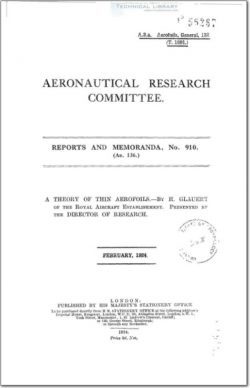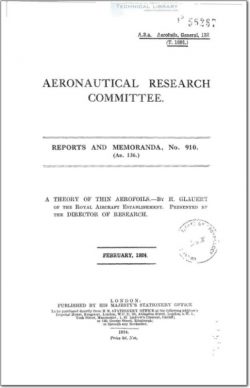ARC-RM-910

- Version
- 206 Downloads
- 1.59 MB File Size
- 1 File Count
- June 16, 2016 Create Date
- June 16, 2016 Last Updated
A Theory of Thin Aerofoils

The general theory of aerofoils in two dimensional
motion at small angles of incidence indicates linear relation—
ships between lift coefficient and angle of incidence, and between
moment and lift coefficients. Also the slope of these curves
does not show any considerable variation between different
aeroioil sections and so the problem of determining the character—
istics of a given aerofoil section is essentially that of determining
the angle of incidence at which the lift vanishes and the corre—
sponding value of the moment coefficient. In addition there is
the yet unsolved problem of determining the drag of an aerofoil
in two dimensional motion. When these characteristics are
known, the behaviour of any finite aerofoil or system of aerofoils
in three dimensional motion can be deduced by Prandtl’s theory.
The present report develops a method of determining the
angle of no—lift and the corresponding moment coefficient for a
thin aerofoil of any given shape. A treatment of this problem
has been given by Munk in Report No. 142 of the National
Advisory Committee for Aeronautics, but the analysis is not
quite free from errors. The present report adopts the general
principles used by Munk but presents the analysis in a more
logical order.
2. General Aaalysz's.~The basis of the we dimensional
aereieil theory initiated by J oukowski depends on the possibility
of converting a circle in the z plane into the desired aerofoil
shape in the g plane by means of a suitable conformal trans-
formation. The present analysis will be confined to the case of
a thin aerefoil in which it is possible to replace the aerofoil
approximately by a curved line which will be the mean of the
upper and lower surfaces of the aerefoil. This assumption
simplifies the analysis considerably and has been found to lead
to very satisfactory results for ordinary aerofoil shapes.
| File | Action |
|---|---|
| ARC-RM-910 A Theory of Thin Aerofoils.pdf | Download |
Comment On This Post